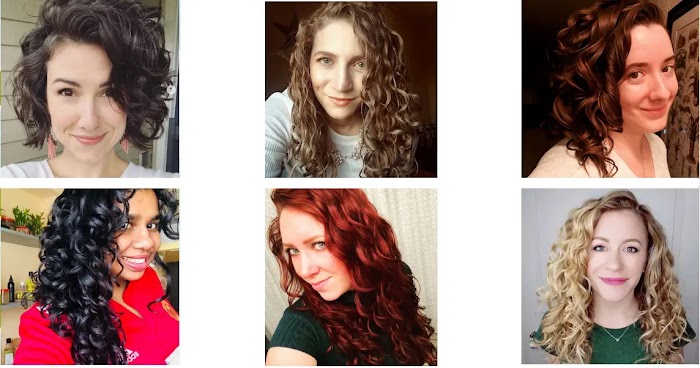The best way to know the definition of your curls is after washing and air drying your hair without a product. Knowing your hair type will enable you to choose more suitable products and will help provide you with instructions on how to treat its hair.
It is very common to have more than one hair texture. Her fringes maybe 4B while the majority of her hair is type 4A. Or they may have 4a hairs with some 3c strands for example.
The Andre Walker poetry writing system is not a 100% solution for understanding your hair type, but it does give you a good starting point. The classification system ranges from straight hair types to Coily hair types.
However, André Walker, the father of writing poetry, has managed over the decades to divide them into four categories - very broad and very general - straight, wavy, Coily, and coiled. Keep reading to see how to deal with it all.
The first type: straight hair
Straight hair can range from smoothy and thin to thick. But there's one thing all straight hair types have in common? This megawatt shines, thanks to the fact that the oil from your scalp can easily slip and glide over the lengths of your strands to keep them hydrated and healthy. Although some would argue that there is only one type of straight hair - straight - I believe there is a variety of textures out there. Important:
Type 1a
This tends to be the most delicate, thinner, and silky straight hair. Keeping a pin or elastic band in your straight hair is a magic trick.
Type 1 b
Still straight, but with some bends and some rough strands. Your biggest enemy is oily roots, not puffiness and dry ends.
Type 1 c
It's thicker and coarser, which also means it's more prone to wrinkling, toxicity, and dryness. If your straight hair has also been damaged (chemical treatment, color, and heat treatments), it likely falls into Type 1 c.
5 Best products for type 1 straight hair in 2021
Type two: wavy hair
Wavy hair tends to have final bends - and multiple - from roots to ends. Meaning if your hair has "one or two strange bumps," you are likely looking at the first type straight, as opposed to the second type of wavy hair. Type 2 waves can range from perfect beachy waves to subtle, indeterminate waves, and they are also one of the easiest hair types to play with.
Type 2 a
Unlike 1c hair, 2a hair strands have a flat S-shaped pattern that gives them waviness. 2a hair tends to be finer and flatter and can be easily blown and straightened.
Type 2b
2b waves have a more defined S shape - usually with fine and/or medium thickness - and are more prone to frizz and pollution, especially if your hair is damaged.
Type 2 c
It's still mostly S-shaped waves, but with a few loose curls and rough textures mixed with. 2c Hair tends to curl easily and is easy to define quickly.
5 Best products for type 2 wavy hair in 2021
The third type: curly hair
To be part of a curly hair racket, your hair needs to have real curls - that is, pieces that spin themselves like a spring, versus pieces that curl back and forth in a flat S shape. It's common - and likely - to have a mixture of curl texture (and even some waves!) On your head in one go.
Type 3 a
Unlike 2c hair, which often has waves and some loose curls, 3a hair is mostly loose curls and a few waves. 3A ripples tend to be finer, burst easily and interact greatly with the elements (moisture, wind, and dryness!).
Type 3 b
3b curls are usually the contour of your finger or your mark. These curls are springier and tighter than 3A curls, but they are also more prone to dryness and frizz.
Type 3 c
3c curls are noticeably tighter than 3b curls - think pipette or pencil volume - and densely packed together, giving your hair that extra volume. It is also more prone to dryness and breakage than Type III curls.
5 Best products for type 3 curls in 2021
Type four: Coily hair
Coily hair can have a mixture of textures that range from a tightly wrapped, springy style (S shape) to a wavy style that doesn't wrap around (Z shape). Because of its kinks and angles, scalp oils cannot condition your strands easily, making Type 4 hair the most brittle, dry, and damaged hair - but it is also the most versatile in styling.
Type 4 a
4a has narrower and smaller coils - often mixed with some 3-tone curls - that can hardly wrap around a crochet needle. Can your profiles lose moisture quickly, which means washed and cleaned?
Type 4 b
Rather than wrap or wrap around themselves, the 4b (and c!) Strands bend into a sharp, sinuous shape and have a springy contour in a ballpoint pen. 4b hair is more prone to shrinking than 4a, so keep your hair tight and defined with your new
Type 4 c
The Z-style 4c is tighter than 4b and naturally has fewer layers of cuticle than any other hair type (FYI: skin retains moisture and protects hair from damage), which means it needs moisture, moisture, and more moisture.
5 Best products for type 4 coils in 2021






